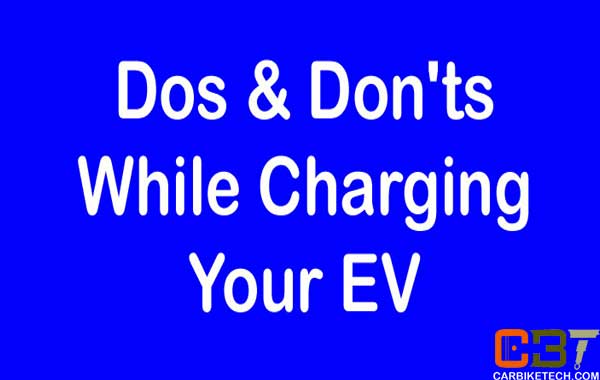What are the Do’s & Don’ts while charging your EV?
Just like mobile phones, you must take care while charging the EVs. It is mainly because of the high voltage current needed for charging them. But, remember that as mobile phones could catch fire if not charged properly, EVs could also. So, the technology comes with both pros & cons. Following these Dos & Don’ts while charging your EV will help you safely charge your EVs.
As this technology is entirely new to us, we must take utmost care while handling it. Unfortunately, there have been incidents where the EVs caught fire or chargers exploded while charging the EVs. One of the reasons given by the experts could also be the high ambient temperatures. Manufacturers also might not have designed & developed the EV battery exclusively for the specific market/climatic conditions or charging cycles. The other reason could be using the wrong type of charger.

Improper production, exterior damage, or ineffective or faulty software can also cause the lithium-ion battery to catch fire. Besides, excessive heat generation can occur within the battery’s failed or damaged cell. Thus, it leads to a “Thermal Runaway.” In the “Thermal Runaway,” the heat produced from a failed cell can pass on to the next cell.
Thus, it causes a chain reaction that results in a fire. It can happen when a defect in manufacturing allows impurities to leak into the lithium-ion cell. Besides, EV makers could also alter the Battery Management Systems when manufacturers attempt to make a compact design that can damage the separator.
Top 10 Factors Contributing To Fire Hazards As Explained By The Battery Experts:
- Not using the software-based BMS. Only using the hardware-based BMS.
2. Software-based BMS cuts off the battery current if the battery temperature exceeds 60 degrees.
3. The battery current remains cut off until high battery temperature.
4. It makes the connection again, only if the temperature drops to 40 degrees. Thus, BMS safeguards the battery from overheating.
5. Not providing a mobile-based app for monitoring the battery parameters. It is also possible that some manufacturers used one set of cells for testing and another type for production purposes. Thus, they got away with passing the testing parameters.
6. Not providing enough cooling for the battery or the motor, such as thermal pads or liquid cooling.
7. Lithium Iron Phosphate battery is safer to operate. Its life cycle is 1200-1500 cycles.
8. Nickel Magnesium Cobalt Oxide battery has a higher energy density than the Lithium-Ion Phosphate battery.
9. However, it tends to heat up faster than the Lithium Phosphate battery.
10. If you increase the Ah value, the range also increases. Besides, it also heats the battery considerably. So, please have a look at the Ah value before buying an EV.
Top 10 Do’s & Don’ts While Charging Your EVs:
Following are some of the tips to avoid such incidents. Following these Dos & Don’ts while charging your EVs tips will make your EV charging process safer and more secure. It will also help clear any doubts in your mind regarding the use of DC Fast Charging in general.
- Use the correct charger for your EV as recommended by the manufacturer. Charge your EV in a well-ventilated area. It is because if there is a fire, then you could suffer due to suffocation from toxic flames.
- Avoid charging the EV inside the home/room. Instead, charge your EV, preferably in a garage or dedicated parking area.
- Don’t leave charging the EV overnight/unattended.
- Don’t plug the charger into an old/worn-out socket.
- Unplug & disconnect the charger if it heats up excessively.
- Regularly check the charging cable for cuts/damages.
- Don’t charge your EV near combustible materials such as fuels, cotton, old clothes, dry grass, etc.
- Do a regular check-up of the electric socket/charger for damage.
- Also, check for any smoky smell coming from the socket/charger and STOP/SWITCH OFF the current.
- Carry out regular maintenance of your EV. Show your charger/EV immediately to an authorized dealer in case of noticing a fault.
By following these tips on Do’s & Don’ts while charging your EV, we are sure that you will be safe & sound with your EV. This technology is new & the future of transportation & mobility.
So, Let’s Pledge To Make It Successful.
These tips were shared with us by the Battery Buddy, a mobile-based app to monitor the health of your EV battery.
